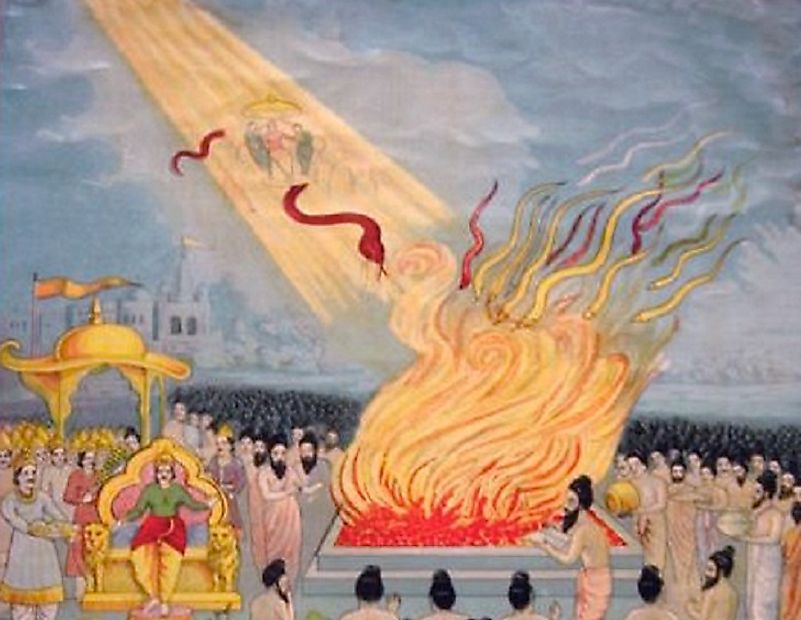Nag Panchami - The Hindu Snake Festival

Description
While snakes (especially the venomous ones) are feared in most parts of the world and shunned for their ability to deal fatal bites, in India and Nepal there is a Hindu festival makes people see snakes in a completely different light. During the festival of Nag Panchami, Hindus worship the snakes of the snake world. The festival is held as per the Hindu traditional calendar and is usually celebrated in the months of July or August. During this festival, the Hindus pray to the snake god for the welfare and prosperity of their family.
Origins of the Festival
A very interesting mythological tale is related to the initiation of snake worship in Hinduism. According to the Mahabharata epic, a king of the Kuru Dynasty, King Parikshit, suffered death when bitten by the snake king Taksaka. Parikshit’s son, Janamejeya, was so angry at his father’s death that he decided to seek revenge and kill all snakes residing in the world. So, with the help of learned Brahmin sages, he set up a massive sacrificial fire, the Sarpa Satra. The power of the sacrificial fire then started pulling all snakes of the world into it, where they burnt to death. Taksaka, foreseeing his death, went to the Hindu God, Indra to seek refuge and coiled himself up against the cot where Indra sat. However, the power of the sacrificial fire was forceful enough to start dragging in Indra and Taksaka together into the fire. Fearing the consequences, the gods in heaven prayed to Manasadevi, a Hindu folk Goddess of snakes, to stop the devastation triggered by Janamejeya. She then sent her son, Astika, a learned Brahmin to convince Janamejeya to stop the sacrifice. Impressed by his wise words, the latter asked Astika to seek a boon from him. Taking the opportunity, Astika asked Janamejeya to stop the proceedings of the sacrifice and forget all that happened in the past. Unable to put down his promise of gifting a boon to a Brahmin, Janamejeya yielded and the mass sacrifice of snakes soon stopped. From then on this day began to be celebrated as Nag Panchami and the serpents became objects of worship. People believed that since the serpents were gifted with renewed lives on this day, out of joy, they are ready to bestow their powerful blessings to all who worship them on this auspicious day.
Significance to Hinduism
Snakes have been an integral part of Hindu religious worship since time immemorial. The snakes are associated with the supreme Hindu gods, Lord Shiva (who has a snake coiled around his snake) and Lord Vishnu (who is pictured resting on a giant multi-headed snake). Snakes are thus believed to posses superpowers that humans lack. Snakes are also believed to influence the horoscope of a person and those with a kalasarpa dosha (an astrological problem caused by black serpents) are held to be doomed in life. Thus, snake worship is an integral part of the lives of these Hindus who fear the wrath of the serpents. Nag Panchami helps them exhibit their respect for the serpents of the world and seek blessings from the serpents for a long and safe life.
Rituals and Observances
A number of interesting rituals are observed by Hindus on the day of Nag Panchami. They believe that by paying respect to the snakes, they will avoid poisonous snakes striking them or their family members in the future. They feed the Brahmins on this day while fasting themselves. While in some places, images and idols of snakes are worshiped, in other places real snakes are also worshiped. Digging grounds on such days is considered inauspicious as this act might kill a snake. Bowls of sweetened milk and rice pudding are often left in the open near termite holes or other places where snakes might reside. Sisters also try to appease the snakes by offering them milk and worshiping them to protect their brothers against snake bite. Overall, the entire proceedings of Nag Panchami reveal the deep respect the Hindus feel for the most venomous creatures of nature and instead of treating these animals with disgust, they revere them highly for their incredible power to kill.
Pilgrimages and Tourism
Celebrations of Nag Panchami in various parts of India as well as in Nepal involve their own distinct rituals, customs, and flavors. The uniqueness of the festival attracts many tourists to visit India and Nepal to witness the festivities of snake worship. The Indian cities of Nagpur in Maharashtra, Varanasi in Uttar Pradesh, Bhuj in Gujarat, and Coorg in Karnataka are famous for their elaborate Nag Panchami celebrations. The Changu Narayan temple in Kathmandu, Nepal is also renowned for its worship of snakes on Nag Panchami.







